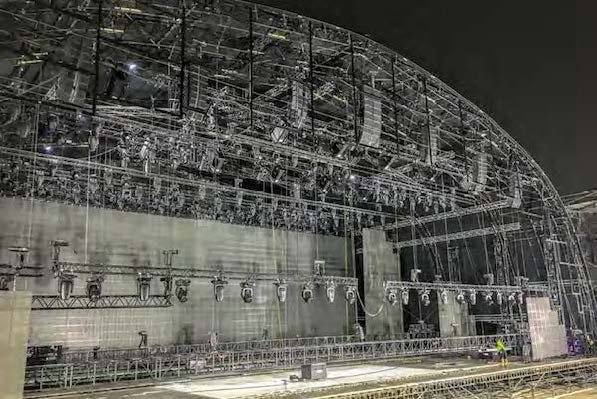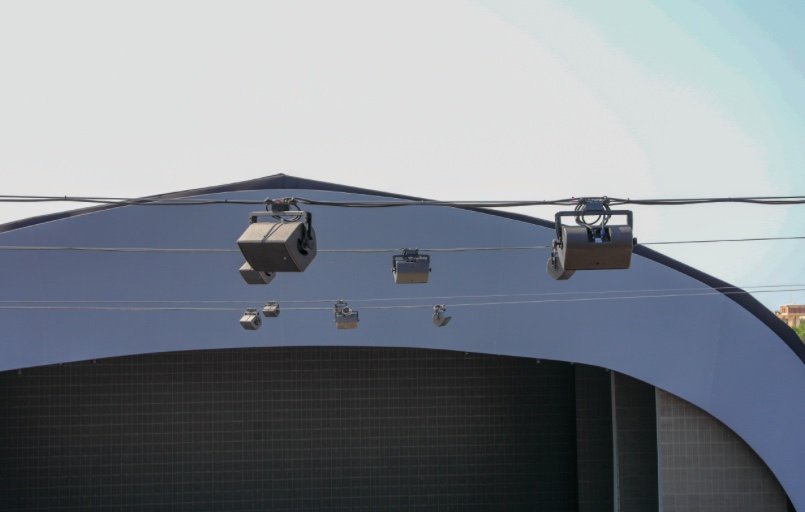News
15 Feb 2018
L-Acoustics L-ISA in Abu Dhabi

Subscribe to CX E-News
LIVE SOUND
L-Acoustics L-ISA in Abu Dhabi – Auditoria’s Scott Willsallen
goes Spatial
The UAE’s 46th National Day was celebrated in Abu Dhabi on December 2 with a host of special events, including a ceremony held for 1800 in a temporary outdoor venue. Auditoria’s Scott Willsallen was Audio Director and Sound Designer for the event, and used L-Acoustics’ L-ISA spatial audio system to totally immerse the audience in sound. Jason Allen spoke with Scott about 3D mixing, system design for spatial, and the future of live sound…
Celebrating the unification of the emirates into one state in 1972, National Day is a major public holiday and cause for wild celebration in the UAE. With UK/LA based TV production and staging company Done+Dusted the winning bidder to produce a spectacular ceremony to mark the occasion, Australia’s Auditoria were brought on via technical producer Nick Levitt to design and deliver a major spatial audio component for the show.

“We’d learnt about the current offerings in spatial audio for a previous project,” said Scott Willsallen. “We developed and conducted evaluations of those products, but L-Acoustics L-ISA wasn’t involved, so I spent a month with L-Acoustics in mid-2017 working with them to understand the product. It’s obvious spatial audio is the next big thing and I wanted to be very well educated about the different products and their capabilities.”
A Sense of Space A temporary outdoor auditorium measuring 60 metres wide by 50 metres deep, seating 1800, was purpose built for the show, which featured live performers interacting with recorded music and sound design.
“The sound design goal was to deliver not just horizontal surround, but to add an element of height as well,” Scott explained. “We wanted to move sounds around in a believable fashion, which can be easy if the audience area is small, but ours was quite large. All of our inputs were pre-recorded, which was advantageous, and we were involved with the music team in the production of the music as well.”
“All of the mic techniques used to capture the orchestra and traditional instruments were to suit the delivery system. The orchestra was recorded in large rooms, with seven mics across the front a few metres off the ground. That gave us our seven main outputs. It took a lot of time to place the mics, listen, and then adjust, to capture, good, wide, and full reproduction. Taking the time to do this meant that the orchestra went from potentially 40 stems to seven.
We used seven cardioid mics, added a few room mics for a reverberant input, and used some 7.1 reverbs for their seven outputs. We ended up with seven orchestra mic tracks, seven orchestra close mic tracks, and seven channels of reverberation, all artfully mixed at Air Studios in London by Adam Miller.”
- Open Air
- L-Acoustics Kara on the sides
- The acoustic ceiling
- L-Acoustics X8s as an acoustic ceiling
Making the Room Without a ceiling or indeed much in the way of walls to create an actual acoustic, Scott and the team ran 33 L-Acoustics X8 speakers in a grid over the audience, giving them the ability to create an ambience.
“We put delays on the reverberation channels and sent that to the overhead speakers to provide an acoustic ceiling,” elaborated Scott. “We had no reverberant energy at all, as we were outside. Overhead speakers are a powerful tool, as the speakers are all the same distance from the listeners, making it possible to create an accurate illusion of a space.”
At the FOH ops position, 280 inputs came in to two DiGiCo SD-5 mixers.
“Every spoken or sung voice, every traditional instrument, every reverb, was a separate track,” Scott continued. “There were 100 channels of sound design and 21 channels of orchestra. We had around 200 active channels per music cue, which meant that cross- fades between cues were about 400 channels. We translated this to 90 inputs to the L-ISA processor, some bussed down from replay, others not.
“The music went straight in, but we used Pryramix to pan the sound design and bounce it down to 36 SFX channels. We took 36 outputs from L-ISA to the PA. The typical L-ISA configuration runs at 96kHz, which gives you 64 in and 32 out, but we ran in alternate configuration at 48kHz, allowing us 96 in and 64 out, of which used 40 outs, one per the 36 arrays plus four for auto-mixdown.”
RIGGING THE GIG
Six arrays of nine elements of L-Acoustics Kara and one array of nine elements of L-Acoustics K2 ran as the main FOH PA, augmented by 18 L-Acoustics SB28 subwoofers.

Four arrays of eight elements of Kara were used as extensions to the main stage system to add width and panorama to the orchestra and choir, while the surround system used 10 arrays of six elements of Kara as sides and rear, with an additional seven X8. In addition to the 33 X8s as the ‘acoustic ceiling’, L-Acoustics ARCS IIs and X8s were used for front-fills, bringing the total of L-Acoustics boxes on the gig to 228.
Local production house Delta Dubai supplied the rig, and L-Acoustics supplied the L-ISA processors. Steve Logan was the replay operator, Justin Arthur the mix engineer, Scott handled the L-ISA interface, and local crew were supplied by Delta, managed by their project manager Craig Harvey.
With all those boxes in the air and processing on the ground, what is the artistic benefit of spatial audio?
“The whole point of spatial mixing is that rather than panning using amplitude to determine where something sits between left and right, you place it within the loudspeaker array that puts it between the far left and far right, and no matter where you are in the horizontal plane, that position will hold true.” Scott illustrated.
“It’s no longer about amplitude difference. If you want to take a five- piece band and make that stereo mix applicable to every seat in the house, then that’s where a 3D mixing system, suitably designed, will change your world. The difference is beyond words.”
The Future of Spatial Audio Arguably the biggest change in live sound reinforcement since L-Acoustic’s introduction of the modern line array in the 90s, spatial audio is set to change PA design across the spectrum of events. Where does Scott Willsallen see the new systems being deployed?
“Well, if I’m doing a stadium, in-the-round ceremony style gig, it has little benefit,” he observed, “but anything from an arena down, depending on content, there’s an argument for it. It’s going to come down to sound design versus set design. In theatre, a proscenium arch is a valuable piece of real estate. The audience in a theatre is close enough to feel the difference and get huge benefits, but it’ll come down to priorities.”
And in the touring market? “Many stage designs for touring rock consists of loads of LED on the back wall, and the designers have accepted a big long black or brown line of PA either side of stage,” added Scott.
- The auditorium in progress
- StageReady
“It’s going to take time for that paradigm to change to a band across the top, four metres(ish) tall, every five metres. There’s also the problem of the front few rows; that’s the hardest part of these systems. How do you deliver spatial representation without damaging intelligibility? The most simplistic answer at the moment is to make the front fill mono, which is a good way out because it conveys the information, but over the next few years designers will preference as to whether it’s a combination of both mono front fill and spatial, or not. It’s going to be content and geometry specific.”
This article first appeared in the print edition of CX Magazine February 2018, pp.18-23. CX Magazine is Australia and New Zealand’s only publication dedicated to entertainment technology news and issues. Read all editions for free or search our archive www.cxnetwork.com.au
Subscribe
Published monthly since 1991, our famous AV industry magazine is free for download or pay for print. Subscribers also receive CX News, our free weekly email with the latest industry news and jobs.













